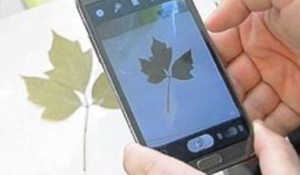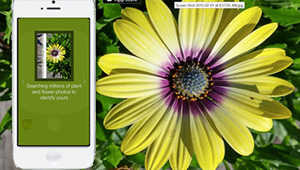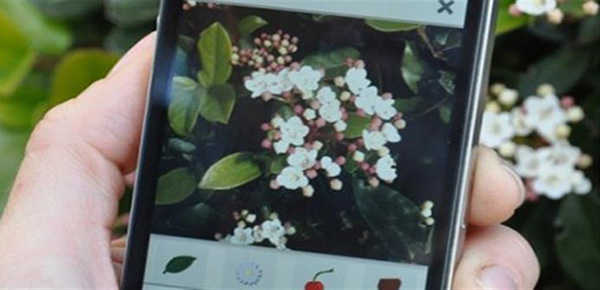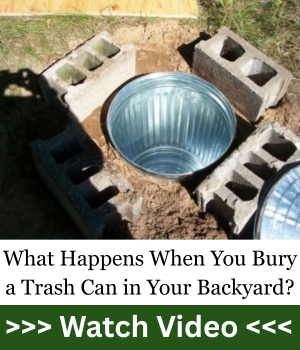From now on it will be really easy when you’re in the woods foraging OR in your garden, wondering what is the new mysterious weed growing right next to your tomato plants.
In a crisis I don’t know how useful this app will be. Or whether our phones will work or not.
But one thing’s for sure: if you keep using it, you’ll get to learn a lot about the plants that grow in your area: which ones are edible or not, which ones are medicinal plants or poisonous! Knowledge that will definitely give you an advantage.
There are 2 types of apps:
For Trees – “Leafsnap”
 A free app for iPhone created by Columbia University, the University of Maryland, and the Smithsonian Institution developed a visual recognition software to help identify species from photographs.
A free app for iPhone created by Columbia University, the University of Maryland, and the Smithsonian Institution developed a visual recognition software to help identify species from photographs.
The technology is similar to facial recognition software and enables users to take a simple photo of a leaf and have it matched to a similar one in their database.
Leafsnap is extremely easy to use. All you need to do is to take a leaf from the tree and place it on a white paper. Enter the app and take a picture. In a second you’ll receive 1-10 trees with similar leafs. Then it’s easy to pick the one with leafs exactly like yours and find out more about it. If two or more photos are very similar and you can’t tell the difference, then simply select the one that grows in your area.
Related: Trees That Can Be Tapped For Sap And Syrup
After you finish this short process (a few seconds) the application returns multiple different images of the leaves, seeds and flowers and some info about the tree.
For Plants – “Like That Garden”
 The innovative tool helps people find out the name of flower simply by taking a picture of it. The app uses a network of trusted horticultural experts and a database of over 6,000 plant species to quickly identify the flower. It is hoped that once a strong database has been built up, the app will be able to identify plants automatically without the need to consult experts. And they almost achieved this level, but only in UK.
The innovative tool helps people find out the name of flower simply by taking a picture of it. The app uses a network of trusted horticultural experts and a database of over 6,000 plant species to quickly identify the flower. It is hoped that once a strong database has been built up, the app will be able to identify plants automatically without the need to consult experts. And they almost achieved this level, but only in UK.
The application works great. I found my plant in minutes.
I just wanted to know if the plants growing in a particular part of my garden were weeds or re-growing plants (after harvest). I found out they were small burdocks, which should be removed before they grow prickly heads.
Now, if you want an application that is particularly for Wild Plants you can get the Audubon Wildflowers App, but it’s not free; it costs $4.99 and you might not need it, since Like That Garden and Leafsnap are also capable of identifying a lot of wild species. There are some other local applications like GSM Wildflowers which is particularly useful for Great Smoky Mountains of Tennessee and North Carolina.
You may also like:
 Best Backup Heaters You Can Buy For This Winter
Best Backup Heaters You Can Buy For This Winter
The Berry That Is Illegal To Grow, But Perfectly Fine To Forage (Video)















It’s ‘2 different kinds of apps’. Who’s your editor?
You “found out they were small burdocks, which should be removed before they grow stinging nettles.”? If this is what you found out from the app, then please delete the app. Burdock and stinging nettle are two very different plants. Both are food. Both are nutritious. I intentionally grow both and would remove neither.
How did you get stinging nettles, out of “prickly heads”? Burdock will get a prickly head when it starts to mature. I suggest that you read the whole statement instead of making assumptions.
Winter…That was a really a vicious reply.
perhaps being a bit curt will make the point more memorable – speak when you have all the facts?
looks kool
what about Android phones I use samsung as do millions of others,and would put a link to your apps from my large site if it worked with them.whenyou have one let me know.
For Android you can try to download Flower Identification here https://play.google.com/store/apps/details?id=cz.thran.flowerchecker&hl=en
They have a team of botanists behind the project so you should get pretty good answers, but probably not on the spot. The downside is that they charge $1 / plant identification.
Be careful with this app. They were wrong a couple of times. When I hear from “The experts,” I always follow-up with my own research. You want to be REALLY sure what plant you are eating or using for medicine. Send them the best pictures you can in the best light.
When/are you releasing an app for plants in the Southern Hemisphere?
This would be very useful Down Under 🙂
Outstanding. Thank you for taking time to share such great apps. Forget about the nasty comments. Instead people could just inform us of potential errors. Let them take their time to do something positive
Thank you, for sharing your knowledge of so many important things from the past. I look forward to reading your articles everyday and putting it in my thoughts and using this important information. Great job!!
c davis you can’t please all of the people all of the time
good app thanks
True! Thanks!
You mention plants like polk and mayflower as extremely haphazardly and to stay away from them.I’ve been eating polk and keeping a patch in my garden for years,very good eating.Mayflower fruit same way,still alive after 75 yrs.Some info presented by you could make people miss out on good things or kill themselves.Be familiar folks.
I run a seperate specific search on any answer I get just to be sure. I also use two other apps similar to this one. This app generally id’s correctly but I would hate to accidently come in contact with Giant Pigweed, not likely though as I live where cactus and Palo Verde trees grow.
i believe pigweed is amaranth, which is highly nutritious.
Many common weeds have been nick-named “Pigweed” over the centuries and can easily refer to several different species of plants [ex: Amaranthus (amaranth), Chenopodium Album (lambsquarter) or Portulaca (purslane).
Best to familiarize yourself with the proper Latin names for the plants you’re identifying.
Be prepared. Be safe.
“Like That Garden” app is no long available here in Nov. 2024 – got another app for suggestion?
Like That Garden – app is no long available here in Nov. 2024 – got another app for suggestion?
like that plant app is no longer available for apple users
Feb 2025